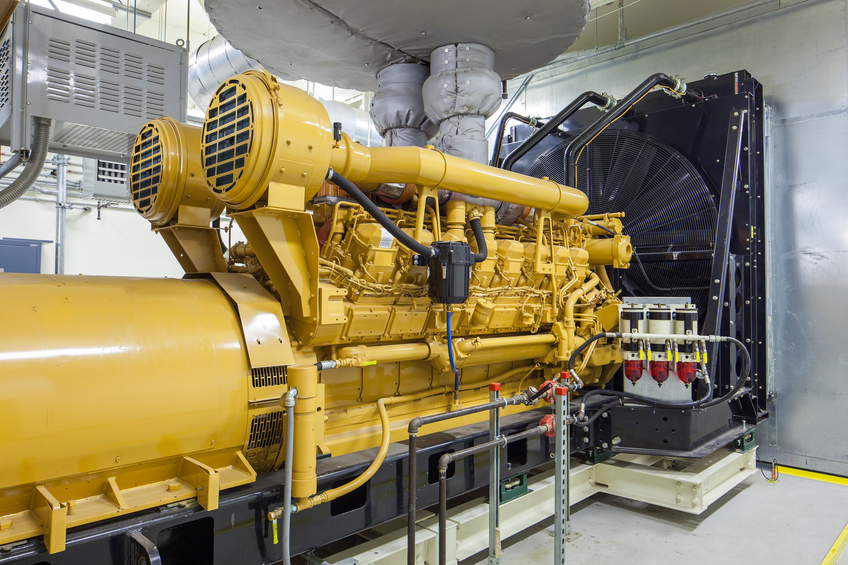Electric Fundamentals 24 PDH Discount Package
Capacitance (E04-004)
Improving Motor and Drive System Performance (E06-006)
Inductance (E03-004)
Inductive and Capacitive Reactance (E04-005)
Matter, Energy and Electricity (E04-003)

This online engineering PDH course provides a basic introduction to AC theory. The text is arranged to let you progress at your own pace, and concepts and terms are introduced as you need them, with many detailed examples and illustrations.
An alternating current (AC) is an electrical current whose magnitude and direction vary cyclically, as opposed to direct current, whose direction remains constant. The usual waveform of an AC power circuit is a sine wave, as this results in the most efficient transmission of energy.
Like DC, with AC circuits, power is equal to volts x amps, but this is only true instantaneously. Thus the power at any one moment in time is equal to the Volts at that time multiplied by the Amps at that time. If we want to find the average power used, we must take the average of the power at each time interval. Mathematically this is known as Integration. The integral of a sinusoid over one full period is zero, because there is as much time spent below zero as above it.
This 3 PDH online course is intended for professionals as well as individuals who are just beginning a career in electrical work, or who require a basic knowledge of electrical principals and equipment to better their primary responsibilities. This course is also a prerequisite for the all other electrical training.
This PE continuing education course is intended to provide you with the following specific knowledge and skills:
- The differences between AC and DC voltage and current
- The advantages of AC power transmission over DC power transmission
- The "left-hand rule" for a conductor
- The relationship between current and magnetism
- The methods by which AC power can be generated
- The relationship between frequency, period, time, and wavelength
- Peak-to-peak, instantaneous, effective, and average values of voltage and current
- The phase difference between sine waves
In this professional engineering CEU course, you need to review Chapter 1 of Module 2 titled "Introduction to Alternating Current and Transformers" of the Naval Education and Training Materials (NAVEDTRA 14173), Electricity and Electronic Training Series.
Upon successful completion of the quiz, print your Certificate of Completion instantly. (Note: if you are paying by check or money order, you will be able to print it after we receive your payment.) For your convenience, we will also email it to you. Please note that you can log in to your account at any time to access and print your Certificate of Completion.

This online engineerng PDH course provides information on capacitance, including electrostatic lines of force, power losses, working voltage and more.
Capacitance is the property of an electric conductor that characterizes its ability to store an electric charge. An electronic device called a capacitor is designed to provide capacitance in an electric circuit by providing a means for storing energy in an electric field between two conducting bodies. A capacitor in its simplest form consists of two conducting plates separated by an insulating layer called a dielectric. When a capacitor is connected in a circuit across a voltage source, the voltage forces electrons onto the surface of one plate and pulls electrons off the surface of the other plate resulting in a potential difference between the plates.
Capacitance is directly proportional to the electrostatic force field between the plates. This field is stronger when the plates are closer together. Therefore, as the distance between the plates decreases, capacitance increases. Also capacitance is directly proportional to the plate area. Larger plates provide greater capacity to store electric charge. Therefore, as the area of the plates increase, capacitance increases.
This 4 PDH online course is applicable to electrical engineers, design and construction personnel, technical staff and facility personnel who are interested in gaining a better understanding of capacitance.
This PE continuing education course is intended to provide you with the following specific knowledge and skills:
- Define the terms "capacitor" and "capacitance"
- State four characteristics of electrostatic lines of force
- State three factors that affect the value of capacitance
- State two types of power losses associated with capacitors
- Define the term "working voltage" of a capacitor, and compute the working voltage of a capacitor
- State what happens to the electrons in a capacitor when the capacitor is charging and when it is discharging
- State the relationship between voltage and time in an RC circuit when the circuit is charging and discharging
- Calculate the value of total capacitance in a circuit containing capacitors of known value in series and parallel circuits
- State the difference between different types of capacitors
In this professional engineering CEU course, you need to review Chapter 3 of Module 2 titled, "Capacitance" of the Naval Education and Training Materials (NAVEDTRA 14174), Electricity and Electronic Training Series.
Upon successful completion of the quiz, print your Certificate of Completion instantly. (Note: if you are paying by check or money order, you will be able to print it after we receive your payment.) For your convenience, we will also email it to you. Please note that you can log in to your account at any time to access and print your Certificate of Completion.

This online PDH course presents the basics of motor and drive systems and briefly describes important terms, relationships, and system design considerations. It also provides a roadmap for finding opportunities to improve motor performance, as well as exploring the economics of motor systems.
Electric motors, taken together, make up the single largest end use of electricity in the United States. In the U.S. manufacturing sector, electric motors used for machine drives such as pumps, conveyors, compressors, fans, mixers, grinders, and other materials handling or processing equipment account for about 54% of electricity consumption.
To achieve cost-effective operation and maintenance of a motor and drive system, operators must pay attention to the entire system as well as to its individual components. Often, when investigating efficiency opportunities, operators are so focused on the immediate demands of this equipment that they overlook the bigger picture, which includes the ways in which system parameters affect all the equipment.
This 6 PDH online course is intended for electrical and mechanical engineers, contractors, manufacturers, building professionals and others interested in learning more about improving motor and drive system performance.
This PE continuing education course is intended to provide you with the following specific knowledge and skills:
- Detecting the indications of a poor system design
- Learning about the different types of electric motors
- Understanding motor operating characteristics
- Selecting motors and drives for their corresponding applications
- Understanding load duty cycles
- Familiarizing with common motor selection problems
- Understanding the framework for addressing seven efficiency opportunities
- Familiarizing with the steps that could be considered to improve motor performance
- Gaining a basic understanding of the economic considerations of motor systems
Upon successful completion of the quiz, print your Certificate of Completion instantly. (Note: if you are paying by check or money order, you will be able to print it after we receive your payment.) For your convenience, we will also email it to you. Please note that you can log in to your account at any time to access and print your Certificate of Completion.

This online engineering PDH course presents the topic of inductance and its role in the relationship of current, magnetism, and motion. The relationship of current, magnetism, and motion is important to the topic of inductance.
Inductance is the property of an electric circuit component that opposes any change in electric current. It is a measure of the amount of magnetic flux produced for a given electric current and is designated by letter "L". An inductor is a component designed to produce a specific inductance i.e. having no resistance or capacitance. An inductor, when subjected to an increasing electrical current flow, generates a back voltage that opposes this current. Inductance quantifies how much energy an inductor can store and is expressed in henrys (h). An inductor consists of at least one winding of wire, but it usually has more. Examples of inductors or devices having inductance are transformers, chokes, coils relays and motors.
This 3 PDH online course is applicable to electrical engineers, design and construction personnel, technical staff and facility personnel who are interested in gaining a better understanding of inductance.
This PE continuing education course is intended to provide you with the following specific knowledge and skills:
- Define the term "inductance", "induced emf" and "counter emf"
- State Lenz's law
- List five factors that affect the inductance of a coil and state how various physical changes in these factors affect inductance
- State the principles and sequences involved in the buildup and decay of current in an LR series circuit
- State the three types of power loss in an inductor
- Define the term "mutual inductance" and "coefficient of coupling"
- Given the inductance values of and the coefficient of coupling between two series-connected inductors, solve for mutual inductance, M
- Write the formula for the "total inductance" of two inductors connected in series-opposing
- Given the inductance values of and the mutual inductance value between two coils connected in series-aiding, solve for their combined inductance, LT
In this professional engineering CEU course, you need to review Chapter 2 of Module 2 titled "Inductance" of the Naval Education and Training Materials (NAVEDTRA 14174), Electricity and Electronic Training Series.
Upon successful completion of the quiz, print your Certificate of Completion instantly. (Note: if you are paying by check or money order, you will be able to print it after we receive your payment.) For your convenience, we will also email it to you. Please note that you can log in to your account at any time to access and print your Certificate of Completion.

This online engineerng PDH course provides guidance on inductive and capacitive reactance, their characteristics, functions and more.
Reactance is measure of the opposition to the flow of alternating current caused by the inductance and capacitance in a circuit rather than by resistance. Steady electric currents flowing along conductors in one direction undergo opposition called electrical resistance, but no reactance. Reactance is present in addition to resistance when conductors carry alternating current. Reactance also occurs for short intervals when direct current is changing as it approaches or departs from steady flow (e.g., when switches are closed or opened).
Reactance is of two types: inductive and capacitive. Inductive reactance is associated with the varying magnetic field that surrounds a wire or a coil carrying a current. Capacitive reactance is associated with the changing electric field between two conducting surfaces (plates) separated from each other by an insulating medium.
This 4 PDH online course is applicable to electrical engineers, design and construction personnel, technical staff and facility personnel who are interested in gaining a better understanding of inductive and capacitive reactance.
This PE continuing education course is intended to provide you with the following specific knowledge and skills:
- State the phase relationships between current and voltage in an inductor and in a capacitor
- State the terms for the opposition an inductor and a capacitor offer to AC
- Write the formulas for inductive and capacitive reactance
- State the effects of a change in frequency on inductive and capacitive reactance
- State the effects of a change in inductance on XL and a change in capacitance on XC
- Compute total reactance (X) in a series circuit and indicate whether the total reactance is capacitive or inductive
- Write the formula for total reactance and impedance
- Write the Ohm's law formulas used to determine voltage and current in an ac circuit
- Define true power, reactive power, and apparent power
- State the definition of and write the formula for power factor
In this professional engineering CEU course, you need to review Chapter 4 of Module 2 titled "Inductive and Capacitive Reactance" of the Naval Education and Training Materials (NAVEDTRA 14174), Electricity and Electronic Training Series.
Upon successful completion of the quiz, print your Certificate of Completion instantly. (Note: if you are paying by check or money order, you will be able to print it after we receive your payment.) For your convenience, we will also email it to you. Please note that you can log in to your account at any time to access and print your Certificate of Completion.

This online engineering PDH course introduces the basic concepts and fundamentals behind electricity. Have you ever wondered about all the material or matter around us? What is it? Is there any universal explanation for its appearance, properties, and behavior?
One theory that explained some of the properties of matter was the molecular theory of matter, which states that matter consists of small molecules in motion. This theory provides an explanation of many characteristics of matter, including how heat works and why materials change from solid to liquid to gas. This was followed by the atomic theory of matter, which states that matter consists of atoms made of protons, neutrons and electrons. Matter is closely associated with energy, and the electricity is a form of energy that comes from the movement of electrons among the atoms of the matter (conductor).
This 4 PDH online course is applicable to electrical engineers, design and construction personnel, technical staff and facility personnel who are interested in gaining a better understanding of matter, energy and electricity.
This PE continuing education course is intended to provide you with the following specific knowledge and skills:
- State the meanings of matter, element, atom and energy
- Describe the relationship between matter, energy and electricity
- List the differences between a conductor, an insulator, and a semiconductor
- State the definition of static electricity and explain how it is generated
- State the meanings of retentivity, reluctance, permeability and ferromagnetism
- List the characteristics of magnetic lines of force (magnetic flux
- State how a difference of potential (a voltage or an electromotive force) can exist
- List six methods for producing a voltage (emf)
- State the meanings of electron current and indicate the direction that an electric current flows
- State the relationship of current to voltage
- State the definitions of resistance and conductance
- Describe how the temperature, length and cross-sectional area of a conductor affect its resistance and conductance values
In this professional engineering CEU course, you need to review Chapter 1 of Module 1 titled "Matter, Energy and Electricity" of the Naval Education and Training Materials (NAVEDTRA 14173), Electricity and Electronic Training Series.
Upon successful completion of the quiz, print your Certificate of Completion instantly. (Note: if you are paying by check or money order, you will be able to print it after we receive your payment.) For your convenience, we will also email it to you. Please note that you can log in to your account at any time to access and print your Certificate of Completion.